The IMO is a United Nations specialised agency which has developed international legislation dealing with two key issues for the maritime industry:
- The safety of life at sea.
- Prevention of pollution from ships.
To this end the IMO has, among other things, drawn up two international conventions to address these issues:
- The SOLAS Convention (covering safety of life at sea).
- The MARPOL Convention (covering pollution prevention).
To supplement the principles laid down in the SOLAS and MARPOL Conventions, the IMO developed the International Maritime Dangerous Goods (IMDG) Code. The IMDG code contains detailed technical specifications to enable dangerous goods to be transported safely over sea by vessel and is intended to protect crew members and to prevent marine pollution. The IMDG Code became mandatory for adoption by SOLAS signatory states from 1st January 2004.
- Attention
- This module is an extension to the container module. In order to use this module, some ship specific data relating to the IMDG must be defined beforehand. This includes information about geometry and position of holds, bulkheads and decks, heat sources, ignition sources, accommodation, etc.
- Note
- CTU stands for Cargo Transport Unit. A container of a certain type and size is a CTU.
-
This manual is not an IMDG course. Knowledge of IMDG is assumed.
Layout
A typical layout of a loading module including the extension with IMDG dangerous goods is shown below. Most of the elements are already described for the module to which the IMDG extension has been added. The elements relating to the IMDG extension are numbered and described below.
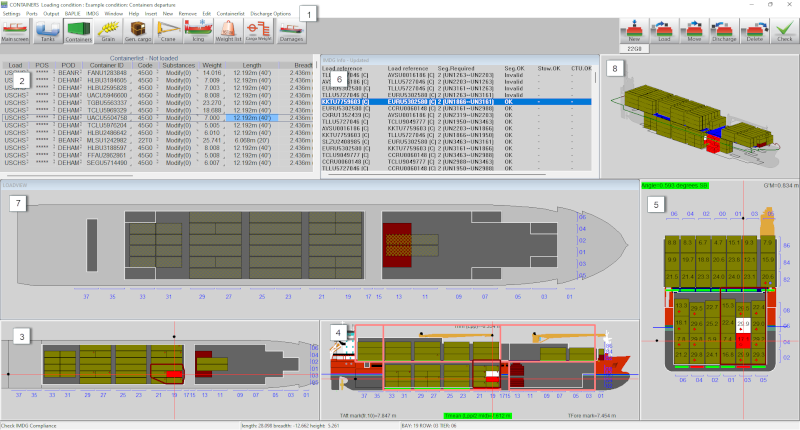
Container module including IMDG extension
- 1 Toolbar options
- For IMDG relevant toolbar options are:
- [IMDG] An activation code can be entered here, which is required to be able to work with the IMDG database.
- [Input] Here containers to be loaded can be defined and relevant properties with respect to IMDG can be specified. From this menu, the UN substances list of the CTUs can be created and edited for each CTU. See Input of IMDG UN substances.
- 2 Container information
- The properties of the selected container are displayed in this window. A number of properties are relevant for the IMDG extension. [CST] (Certified Safe Type) [Container Code] [Substances] (IMDG). Editing of the UN substances list of the selected container.
- 3 4 5 Section windows
- These windows show a section of respectively selected Tier, Bay and Row. If a line is selected in the IMDG info window 6, then the reference CTU (1st column) is shown in bright red in these section views. If the line contains an incompatible CTU (2nd column), this CTU is highlighted in dark red. In this case, the the prohibited zone (according to IMDG 7.4.3.2 table of segregation of containers on board containerships with closed cargo holds) is drawn in the section windows around the reference container. To comply with the IMDG, the incompatible container is not allowed inside this prohibited zone.
- 6 IMDG information window
- This window shows per CTU (if it contains UN substances) a line of information on whether the segregation requirements within this CTU are met [CTU.OK], whether the CTU meets the stowage requirements applicable to this CTU [Stow.OK] and whether the position of the CTU is permitted according to the "document of compliance" belonging to the vessel [DOC.O.C.]. In addition, for each pair of containers (in case they both contain UN substances) a line of information with the required segregation [Seg.Required] and whether this segregation requirement between the containers themselves is met [Seg.OK]. Selecting a line will display a popup with multiple tabs with detailed information on segregation and stowage.
Compliance with IMDG
For the implementation of the IMDG code in LOCOPIAS a toolkit (DLL) from the UK based company "Exis Technologies" is used. They have various tools (both stand-alone applications and online web-based), with which they serve various (large) maritime container shippers / carriers. The toolkit contains an extended database with all IMDG substance information (dangerous goods list) as well as various procedures to request all kinds of segregation and stowage information and has been fully integrated in LOCOPIAS. Exis will keep their toolkit up to date with the latest amendment, thus ensuring LOCOPIAS can always be equipped with the latest version of the IMDG code. The IMDG Code is evolving and is updated every two years to take account of:
- New dangerous goods which have to be included.
- New technology and methods of working with or handling dangerous goods.
- Safety concerns which arise as a result of experience.
In addition to a license for the IMDG module in LOCOPIAS, an annual subscription is required to be able to work with the Exis database. Current Version: Amendment 41-22
Below IMDG "stowage comments" are checked by LOCOPIAS:
- On or under deck / On deck / Prohibited.
- Contains both on-deck-only and under-deck-only items.
- On deck in closed CTU or under deck in closed CTU.
- On deck only in closed CTU.
- On deck in closed CTU or under deck.
- Open units must be stowed under deck.
- SW2 Clear of living quarters.
- SW5 If under deck, stow in a mechanically ventilated space.
- Not to be transported in closed CTUs. Long international voyages are authorized only with the approval of the competent authority.
- Not to be stowed within a horizontal distance of 6m from potential sources of ignition.
- Stow not less than a horizontal distance of 12m from living quarters, life-saving appliances and areas with public access, and not closer to the ship's side than a distance equal to one eighth of the beam or 2.4 m, whichever is the lesser.
- When on deck shall be stowed at least 2.4m (container ships) or 3m (other cases) from any potential source of ignition.
- SW3 Shall be transported under temperature control.
- SW1 Protected from sources of heat.
- SW11 Cargo transport units shall be shaded from direct sunlight. Packages in cargo transport units shall be stowed so as to allow for adequate air circulation throughout the cargo.
Below segregation requirements are checked by LOCOPIAS:
- Class and subrisk segregation of 7.2.4
- Segregation groups of 7.2.5 and 3.1.4.4
- Segregation exceptions of 7.2.6
- Segregation of class 1 of 7.2.7 including the exceptions of 7.2.7.2
- SG codes of 7.2.8
- Limited and excepted quantites of 3.4 and 3.5
- Exemptions in the special provisions of 3.3 and the packing instructions of 4.1.
Input of IMDG CTUs and UN substances

Input of CTUs
Via
[Input]→[ containers] you will find the menu above, where CTUs can be defined. Columns related to the IMDG module are explained below.
- Substances
- A list of UN substances can be specified for each CTU. The substances have a unique number (UN number) and name (PSN). This list can be edited/viewed from this column, but also directly in the graphical interface, when editing the container data.
- CST
- For a CTU it can be specified whether it is of the so-called Certified Safe Type. This has an impact on a number of stowage requirements.
- Note
- Certified Safe Type: For cargo spaces, refer to SOLAS II-2/19.3.2 and for refrigerated or heated cargo transport units refer to Recommendations published by the International Electrotechnical Commission, in particular IEC 60079.
Input of IMDG UN substances
Substances in a CTU can be specified or edited by double-clicking the [substance] column in the IMDG input UN substances menu. The conclusion line at the bottom of the screen shows directly whether there are conflicts in the CTU (does not comply). Below is a brief description of each column.

Entering UN substances into a CTU
- UN no.
- Here you can enter the UN number of the substance.
- Substances
- A substance can also be searched by name. Type in the first character or part of the name, followed by [enter]. An alphabetical list of all UN substances will then be displayed, with the selection on the closest found substance.
- IEO
- Include, Exclude or Override. Here you can specify the following properties of a substance.
- Includes: the substance is included in the CTU load assessment.
- Exclude: the substance is not included in the CTU load assessment. You would typically do this if the load is invalid and you want to see if removing this item solves the problem. The item is reinstated by resetting its status to I, i.e. 'Include'.
- Override: This sets the item status to "overridden" and removes the item from the segregation calculation for both cargo and onboard. A message appears that a substance can only be overruled with the approval of the competent authority.
- Limited quantity: If the substance may be transported with the attribute in "limited quantity", then the limited quantity is displayed in a pop-up window. This substance in the load is then excluded from segregation requirements. If the substance is not allowed to be transported in a limited quantity, this will be confirmed in a popup window. The substance would still be subject to full segregation requirements.
- Excepted quantity: This indicates that a substance may be carried separately in a certain small amount, in which case no segregation requirements apply for this substance. The allowed amount is displayed in a popup window. If it is not allowed for a certain substance, this is confirmed in a popup window. The substance is still subject to full segregation rules.
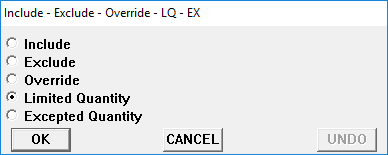
CTU property
- Var
- If several variations are available for a selected substance, a menu appears immediately after entering a single number or name of the substance where the desired variation can be selected. The variation can be changed later by selecting this column.
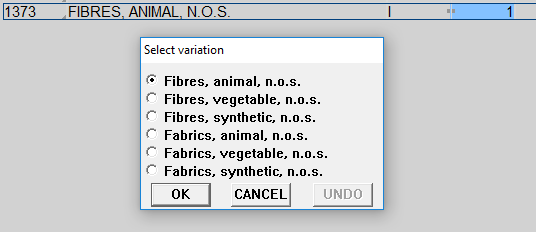
Choice of a substance variation
- Class
- This column shows the class and subdivision of the substance in question (Class and subdivision).
- PG
- Dangerous goods are assigned to three packing groups (also called UN packing group) according to the degree of danger. This column is automatically filled from the database after the selection of a substance. Packing group I: high hazard. Packing group II: medium hazard. Packing group III: low hazard.
- Cat
- The number of segregation conflicts with other substances in the CTU is given. By selecting the cell a popup will be shown with the conflicts.
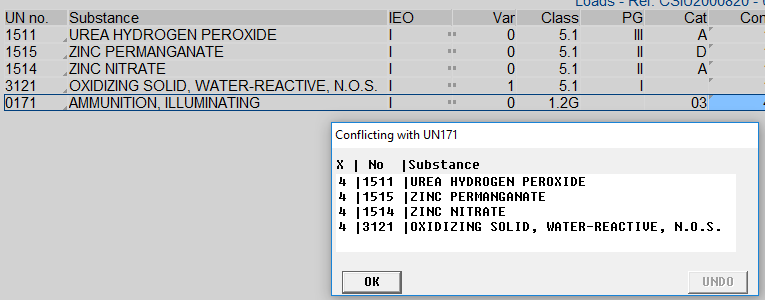
Segregation conflicts in the CTU
- Descr(2)
- Displays the qualifying descriptive text (corresponds to column 2 of the IMGD dangerous goods list)
- P&O(17)
- Shows the properties and observations (corresponds to column 17 of the IMDG dangerous goods list.
- LQ
- If a substance is transported in limited quantities, the limited quantity is specified in this column.
- EQ
- If a substance is transported in an exempted quantity, the exempted quantity is specified in this column.
- Attr.
- Various properties of the substance can be specified.
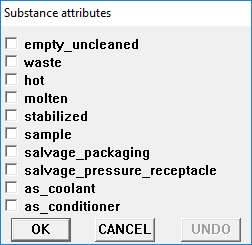
Define various substances characteristics
Menu bar functions
- All LQ
- All substances in the CTU for which this is permitted will be assigned the limited quantity attribute.
- Conflicts
- shows a popup window with all segregation conflicts between substances within the CTU.
- Comments
- shows a popup window with all the stowage comments, grouped by substance.
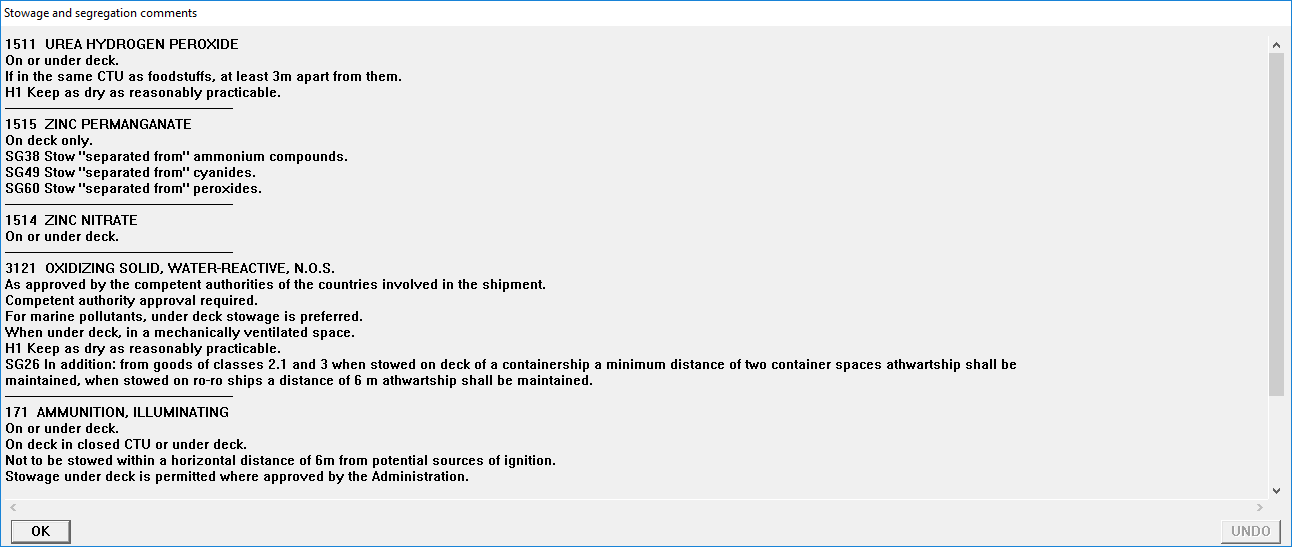
Stowage and segregation comments
IMDG information window
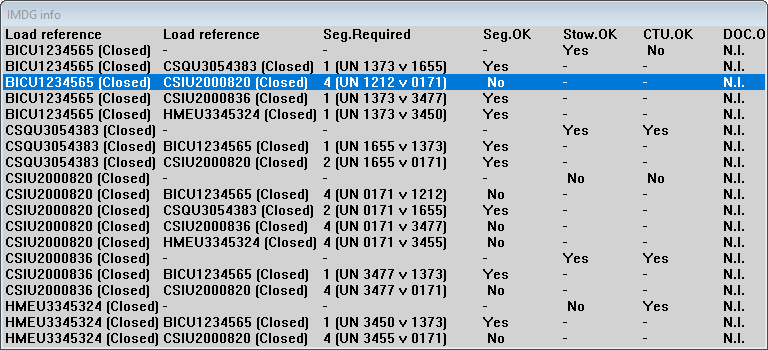
Verification against IMDG. IMDG information window
The IMDG information window provides the following information:
- One row per single CTU (if this CTU contains one or more UN substances). In this case the column [Load reference], [Seg. Required] and [Seg.OK] contain a dash. For this CTU it is indicated if it complies with the stowage comments that can be checked by LOCOPIAS. The conclusion can be found in the column [Stow.OK] (stowage ok). The column [CTU.OK] concludes that there are no segregation conflicts within the CTU itself. In the [DOC.OK] column, the conclusion whether the placement of the CTU is permitted according to the Document of Compliance. For details, double-click on the row. A popup with a number of tabs will show the following detailed information for the CTU with respect to:
- CTU segregation.
- Stowage non-compliant.
- Stowage not checked.
- Stowage compliant.
- Compliance with the vessels Document of compliance.

Verification against IMDG. Segregation within a single CTU

Verification against IMDG. CTU, stowage non-compliant

Control to IMDG. CTU, stowage not checked

Verification against IMDG. CTU, stowage compliant

Verification against IMDG. CTU, verification with document of compliance
- One row per CTU combination (pair) for which segregation is required (contains dangerous substances that cause a segregation requirement between the CTUs). This row shows the (highest) segregation requirement and which combination of two substances in the CTUs causes this. The [SEG.OK] column shows whether the segregation requirement is met. This depends on the relative positions of the CTUs and their mutual orientation in the vessel (bulkheads, decks, bulkheads, etc.). For details, double-click on the row. A popup will then show detailed information about the segregation requirements between the CTUs themselves.
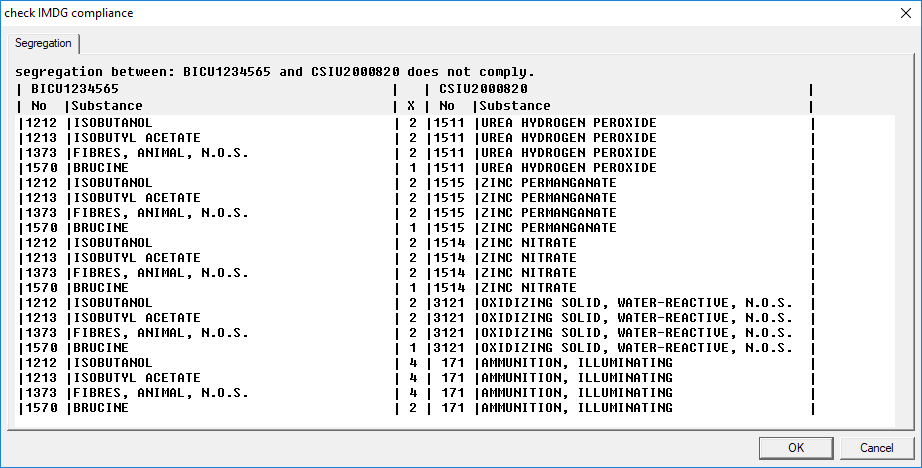
Verification against IMDG. Details segregation requirements between two CTUs
Required ship specific data
For the IMDG module the following additional ship specific information is required:
For verification against stowage codes as mentioned in column 16a of the dangerous goods list:
- Position and dimensions of living quarters, air intakes, machinery spaces, other enclosed working areas.
- In case of SW2, CTU's must be clear of living quarters, which means that packages or cargo transport units shall be stowed a minimum distance of 3 m from accommodation, air intakes, machinery spaces and other enclosed work areas.
- Position and dimensions of sunlight obstructions
- Relevant for cargo transport units positioned on deck (deckhouses etc.).
- Position and dimension of sources of ignition.
- Potential sources of ignition, but is not limited to, open fires, machinery exhausts, galley uptakes, electrical outlets and electrical equipment including those on refrigerated or heated cargo transport units unless they are of certified safe type. (CST)
- Position and dimensions of sources of heat.
- In case of SW1, CTU's must be protected from sources of heat. This means that packages and cargo transport units shall be stowed at least 2.4 m from heated ship structures, where the surface temperature is liable to exceed 55ºC. Examples of heated structures are steam pipes, heating coils, top or side walls of heated fuel and cargo tanks, and bulkheads of machinery spaces. In addition, packages not loaded inside a cargo transport unit and stowed on deck shall be shaded from direct sunlight. The surface of a cargo transport unit can heat rapidly when in direct sunlight in nearly windless conditions and the cargo may also become heated. Depending on the nature of the goods in the cargo transport unit and the planned voyage precautions shall be taken to ensure that exposure to direct sunlight is reduced.
- Position and dimensions of mechanically ventilated spaces.
- Position and dimensions of mechanically ventilated spaces.
For verification against segregation requirements as mentioned in column 16b of the dangerous goods list:
- Position and dimensions of bulkheads (transverse and longitudinal) and decks.
- All bulkheads and decks shall be resistant to fire and liquids).
















